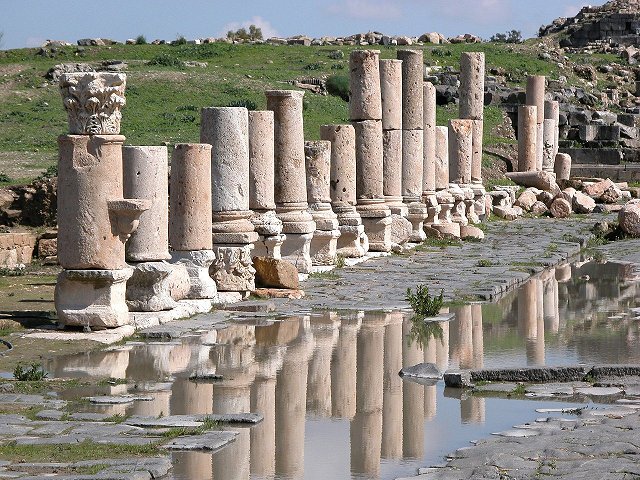|
 
       
       
Gadara, one of the cities of the
Decapolis

The modern town of Umm Qais is the site of the
ancient Greco-Roman town of Gadara, one of the cities of the Decapolis
and, according to the Bible, the place where Jesus cast out the devil
from two men into a herd of pigs (Matthew 8: 28-34). Rising 518 meters
above sea level with views of Lake Tiberias and the Golan Heights, there
is no better vantage point in northern Jordan than Umm Qais.
Gadara was renowned for its cosmopolitan atmosphere, attracting an array
of writers, artists, philosophers and poets. It also served as a resort
for Romans vacationing in the nearby al-Hemma hot springs. Like Pella,
its sister Decapolis city, Gadara was blessed with fertile soil,
abundant water, and a location astride a number of key trading routes
connecting Asia and Europe.
The city was probably founded by the Greeks during the fourth century
BC. Gadara was overrun by the Seleucid ruler Antiochus III in 218 BC.
When the Romans under Pompey conquered the East and formed the
Decapolis, the fortunes of Gadara, taken in 63 BC, improved rapidly and
building was undertaken on a large scale. During the early part of Roman
rule, the Nabateans (with their capital at Petra) controlled the trade
routes as far north as Damascus. Aiming to put an end to this
competition, Mark Antony sent King Herod the Great to weaken the
Nabateans, who finally gave up their northern interests in 31 BC. In
appreciation for his efforts, Rome rewarded Herod with Gadara. The city
remained under Herod’s rule until his death, and then reverted to
semi-autonomy as part of the Roman province of Syria.
The Byzantine era witnessed the decline of Gadara into relative
obscurity. Earthquakes destroyed many buildings, and by the dawn of the
Islamic era Gadara had become just another village. The town became
known by the Arabic Umm Qais during the Middle Ages.
Today, a considerable portion of the original Roman amphitheater has
survived. The seats face west, and are brought to life at sunset.
Covered passageways stand in the back, and until recently, a six-foot
headless white marble goddess sat at the foot of one of the
amphitheater’s internal staircases. The statue—thought to be of Tyche,
the patron goddess of Gadara—can now be seen in Umm Qais’ archeological
museum. The museum, which also houses a Byzantine mosaic frieze and a
marble sarcophagus, is open from 08:00-17:00 in summer, and in winter
from 08:00-16:00, every day except Tuesday. No charge is required.
Next to the theater is a colonnaded street that was once probably the
town’s commercial center.
Also near the black basalt theater are the columns of the great Basilica
of Gadara. Further west along the colonnaded street are a mausoleum and
public baths. After a few hundred meters you can barely make out the
remains of what once was a hippodrome

All
rights reserved, Jordan Beauty Tours©2009 |